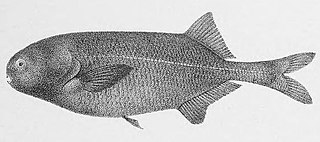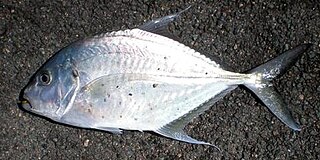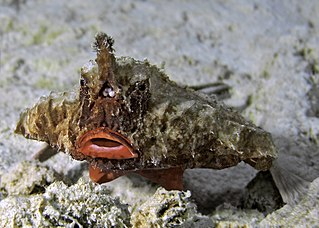
Lake Victoria is one of the African Great Lakes. Though having multiple local language names, the lake was renamed after Queen Victoria by the explorer John Hanning Speke, the first Briton to document it in 1858, while on an expedition with Richard Francis Burton.

A sawshark or saw shark is a member of a shark order bearing a unique long, saw-like rostrum edged with sharp teeth, which they use to slash and disable their prey. There are eight species within the Pristiophoriformes, including the longnose or common sawshark, shortnose sawshark, Japanese sawshark, Bahamas sawshark, sixgill sawshark, African dwarf sawshark, Lana's sawshark and the tropical sawshark.

The longnose gar, also known as longnose garpike or billy gar, is a ray-finned fish in the family Lepisosteidae. The genus may have been present in North America for about 100 million years. References are made to gars being a primitive group of bony fish because they have retained some primitive features, such as a spiral valve intestine, but gars are a highly evolved group of fish, and not primitive in the sense of not being fully developed.

The longnose sucker is a species of cypriniform freshwater fish in the family Catostomidae. It is native to North America from the northern United States to the top of the continent. It is also found in Russia in rivers of eastern Siberia, and thus one of only two species of sucker native to Asia.

Peters's elephant-nose fish is an African freshwater elephantfish in the genus Gnathonemus. Other names in English include elephantnose fish, long-nosed elephant fish, and Ubangi mormyrid, after the Ubangi River. The Latin name petersii confirms it is named after someone called "Peters", although the apostrophe is often misplaced and the common name given as "Peter's elephantnose fish". It uses electrolocation to find prey, and has the largest brain-to-body oxygen use ratio of all known vertebrates.

The longnose dace is a freshwater minnow native to North America. Rhinicthys means snout fish and cataractae means of the cataract. Longnose dace are small, typically less than 100 mm and characterized by their fleshy snout that protrudes past the mouth. They are well adapted for living on the bottom of fast-flowing streams among stones. Longnose dace eat algae and aquatic insects and are important forage minnows for larger predatory fish.

The longnose velvet dogfish is a sleeper shark of the family Somniosidae, found circumglobally in southern hemisphere subtropical seas, at depths of between 230 and 1,500 m. It reaches a length of 130 cm.

The longnose sawshark or common sawshark, is a sawshark of the family Pristiophoridae.

The longnose pygmy shark is a rare species of squaliform shark in the family Dalatiidae and the only member its genus. It is known only from a handful of specimens collected from the cold oceanic waters of the Southern Hemisphere, between the surface and a depth of 502 m (1,647 ft). Reaching 37 cm (15 in) in length, this diminutive shark is characterized by a slender, dark brown body with a very long, bulbous snout. In addition, it has two spineless dorsal fins of nearly equal size, with the origin of the first lying over the pectoral fin bases. The longnose pygmy shark does not appear substantially threatened by fisheries, and has been assessed as Least Concern by the International Union for Conservation of Nature (IUCN).

The longnose houndshark is a houndshark of the family Triakidae. It is found in the western Pacific off northern Australia and Vanuatu, between latitudes 9° S and 26° S, at depths between 250 and 475 m. It can grow up to a length of 75 cm.

Gnathonemus is a genus of elephantfish in the family Mormyridae.
Graham's stonebasher is a species of ray-finned fish in the family Mormyridae. It is found in Kenya, Rwanda, Tanzania, and Uganda. Its natural habitats are rivers, swamps, freshwater lakes, freshwater marshes, and inland deltas. It is threatened by habitat loss.
The Victoria stonebasher is a species of ray-finned fish in the family Mormyridae. It is found in Kenya, Rwanda, Tanzania, and Uganda. Its natural habitats are rivers, swamps, freshwater lakes, freshwater marshes, and inland deltas. It is threatened by habitat loss.
The longnose darter is a species of freshwater ray-finned fish, a darter from the subfamily Etheostomatinae, part of the family Percidae, which also contains the perches, ruffes and pikeperches. It is endemic to the United States.

The dark stonebasher is a species of ray-finned fish in the family Mormyridae.

The longnose trevally, also known as the tea-leaf trevally, club-nosed trevally, grunting trevally or dusky trevally, is a species of inshore marine fish in the jack family, Carangidae. The species is distributed throughout the tropical and subtropical waters of the Indian and west Pacific Oceans from South Africa to New Zealand and Japan, inhabiting coastal waters, especially reefs, to a depth of 90 m. The longnose trevally is distinguished from similar species by a combination of a scaleless breast and the number of gill rakers and fin rays. It is a moderately large fish, growing to a maximum known length of 72 cm and 4.35 kg. The longnose trevally is a predatory fish, consuming small fish, crustaceans and molluscs. The species is of minor commercial importance throughout its range, and is considered to be a good table fish.

Acantopsis dialuzona is a loach native to the swift, clear streams and rivers of mainland and archipelagic Southeast Asia, from India to Indonesia through the Chao Phraya and Mekong river basins. It can also be found in flooded fields.

Lake Nabugabo is a small freshwater lake in Uganda.

The longnose shiner is a species of ray-finned fish in the genus Notropis.

Ogcocephalus corniger, the longnose batfish, is a species of batfish found at depths between 29 and 230 m in the Atlantic Ocean, ranging from North Carolina to the Gulf of Mexico and the Bahamas. Like other members of the family Ogcocephalidae, it has a flat triangular body with coloring varying from yellowish to purple with pale, round spots. The lips are orange-red. Projecting from its head is a characteristic structure that is shared by other anglerfish.


















